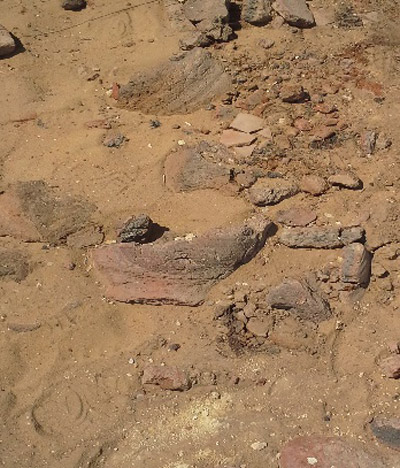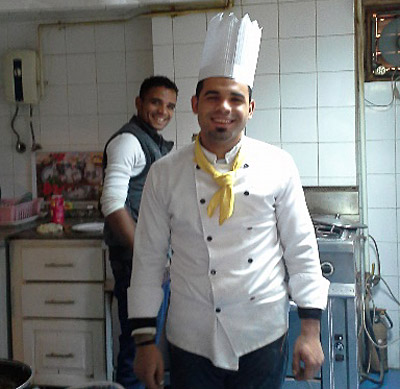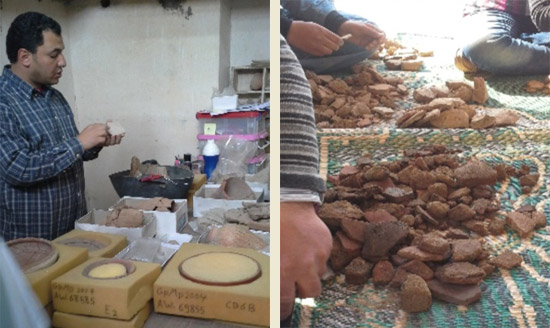Taking daily life for granted
by Debra Karbashewski (AFT/AUC Student)
Imagine that you have never been to a restaurant in your entire life. One day you are granted an invitation to dine out with the world’s best chef. This is how it feels to be a beginner in archaeology field training at Heit el Ghurab (HeG), “Lost City of the Pyramid Builders”.

Pottery dump in ‘Standing Wall Island’. Photo by D. Karbashewski.
What a gift. I have been dropped right into a real excavation directly behind the Pyramids, the most famous archaeology site in the world. The professional team of archaeologists are knowledgeable and patient. My Egyptian counterparts are well versed in archaeology, hieroglyphs and ancient Egyptian culture. They have an incredible eye for details. They are tremendously happy people that have open heartedly accepted me into their study group.
We are studying settlement archaeology. What was daily life like for the pyramids builders? Who knew it would be about bread, beer and meat? It reminds me how we continually take daily life for granted. I never have to think about where my drink, bread and meat will come from. After a long day of digging and cleaning sand, an excellent supply is provided by AERA’s talented cook Ahmed. What a funny twist.

Ahmed, our professional chef. Photo by D. Karbashewski.
My home city, Ottawa, houses the national parliament and many monuments and museums. I am continually surprised by how many local people have never visited some of Canada’s most famous sites. After all, it is right in their backyard. Daily I work next to the pyramids and I find myself forgetting about them. Taking them for granted. Trying to focus on the limits of the architectural structures of our Old Kingdom city. In fact, after four weeks of field school, working right next to the pyramids and sphinx I still haven’t walked around them. I just take for granted that they will be there tomorrow. It is hard to find fault with the grind of daily life since our own field site is quite intriguing. There is so much going on. It is quite the bubbling soup of experts. Surveyors, photographers, ceramic specialists, archaeologists (of course), illustrators, engineers, archaeobotanist, archaeozoologist and osteologists. Not to mention the many visitors from various departments and expeditions. There is no shortage of work or things to think about or experts to tap into at Heit el Ghurab. (See Archaeosoup on YouTube, a great way for a beginner to get the flavour of archaeology)
Every day I walk on top of a fourth dynasty city. I try to take the paths that were the real streets. Why am I guessing? Because at the end of every season the excavation is backfilled. This provides protection to the work and leaves uninvestigated areas available for future missions. So, I am kind of guessing where the streets were. When I left home I thought I would be over the moon to find one little pottery sherd. But there are pottery sherds everywhere. The backfill contains thousands of sherds. Tons of backfill sand contains sherds from the 4th and 5th dynasties and some from the new kingdom. We just step all over tons of it on the ground daily and don’t think a bit about it…as locals have done for 4000+ years. One of our pottery experts, Sheriff, says we will likely collect more than 500 kilograms of pottery this year alone. Every dig on our site has a lot. All of it needs to be picked up and taken to the lab. At the lab the pottery gets sorted and inspected. Why is it important? It can tell us the age of the site and what activities might have been going on in our ancient city. So what was all of this pottery used for? Why, bread, beer and meat of course!

Lab teaching. Pottery from the excavation.
Photos by D. Karbashewski.
